
Artificial Intelligence (AI) is no longer a concept of science fiction—it is a transformative force reshaping industries, economies, and our daily lives. From smart assistants and recommendation engines to self-driving cars and advanced medical diagnostics, AI is rapidly influencing how we live and work.
In this article, we explore what AI is, how it works, where it’s being used today, and what the future may hold as this powerful technology continues to evolve.
What Is Artificial Intelligence?
Artificial Intelligence (AI) refers to the simulation of human intelligence by machines—especially computer systems—enabling them to perform tasks that typically require human cognition.
These tasks include:
Understanding language
Recognizing patterns and images
Making decisions
Learning from experience
Solving problems
AI encompasses various subfields, including machine learning (ML), natural language processing (NLP), computer vision, and robotics.

AI systems rely on three core components:
AI requires vast amounts of data to learn patterns and make predictions. The more quality data, the better the AI performs.
Algorithms are sets of rules or instructions that guide how the AI processes data and makes decisions.
High-performance computing (including cloud computing and GPUs) enables machines to process complex tasks quickly and efficiently.
Most modern AI systems use machine learning, where algorithms learn from data without being explicitly programmed. A popular form of ML is deep learning, which uses neural networks to mimic how the human brain works.
Everyday Applications of AI
AI already plays a major role in technologies we use daily:
Tools like Siri, Alexa, and Google Assistant use AI to understand voice commands, answer questions, and control smart devices.
Platforms like Netflix, YouTube, Amazon, and Spotify use AI to recommend content and products based on your behavior and preferences.
Email services use AI to filter spam, detect phishing, and sort messages intelligently.
AI-powered chatbots handle customer inquiries 24/7, reducing response times and operational costs.
Google Maps and apps like Uber and Lyft use AI for route optimization, traffic prediction, and dynamic pricing.
AI in Industry: Transforming the Economy

AI helps doctors diagnose diseases from medical images, predict patient outcomes, and personalize treatment plans. It is also being used in drug discovery and genomics.
AI detects fraudulent transactions, automates trading, and assists with risk management and credit scoring.
Smart factories use AI for quality control, predictive maintenance, and production automation.
AI analyzes customer behavior, optimizes supply chains, and provides personalized shopping experiences.
AI powers adaptive learning platforms that adjust content to match a student’s pace and understanding.
Benefits of AI
Efficiency: Automates repetitive tasks, saving time and reducing human error.
Scalability: Processes vast amounts of data far beyond human capability.
Insight: Extracts patterns and predictions from data to support better decision-making.
Personalization: Delivers tailored content and experiences in real-time.
Cost Reduction: Lowers labor costs in many industries while increasing productivity.
Challenges and Risks of AI
Despite its benefits, AI presents several serious challenges:
Automation threatens to replace jobs in sectors like transportation, customer service, and manufacturing. While new roles will emerge, workers will need reskilling.
AI systems can inherit and even amplify biases present in training data, leading to unfair or discriminatory outcomes.
AI-driven surveillance, facial recognition, and data collection raise ethical questions about privacy and consent.
Some AI systems, especially deep learning models, are “black boxes”—it’s difficult to understand how they make decisions.
Generative AI (e.g., deepfakes, AI-generated text) can be misused to spread fake news, impersonate individuals, or create false narratives.
AI and the Future of Work
AI isn’t just replacing tasks—it’s also augmenting human capabilities. In many fields, AI assists professionals rather than replacing them. For example:
Doctors use AI for faster, more accurate diagnostics.
Lawyers use AI to analyze legal documents.
Writers use AI tools to brainstorm ideas or enhance content.
The future will require a human-AI collaboration model, where machines handle routine work and humans focus on creativity, strategy, and empathy.
Ethical AI Development
Creating ethical, responsible AI is one of the greatest challenges of our time. Best practices include:
Transparency: Making AI systems explainable and accountable.
Fairness: Removing bias and ensuring equitable outcomes.
Privacy protection: Using techniques like data anonymization and secure AI training.
Human oversight: Keeping humans in the loop, especially for high-stakes decisions.
Organizations and governments are actively developing AI ethics frameworks to guide safe development.
AI and the Next Frontier
Emerging AI trends include:
Generative AI: Tools like ChatGPT and DALL·E create text, images, music, and code.
Autonomous systems: Self-driving vehicles, drones, and robots that navigate the world independently.
AI at the edge: Running AI locally on devices (e.g., smartphones, cameras) instead of relying on cloud servers.
AI for good: Applications in climate change modeling, disaster response, and humanitarian aid.
Conclusion
Artificial Intelligence is reshaping nearly every aspect of modern life. As AI continues to evolve, it promises enormous benefits—if we develop and apply it responsibly.
To succeed in the AI-driven future, individuals and organizations must stay informed, adapt to changes, and focus on ethics and inclusion. The key isn’t to compete with AI—but to collaborate with it.